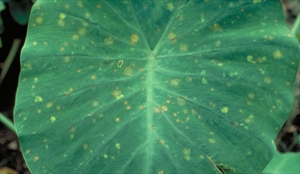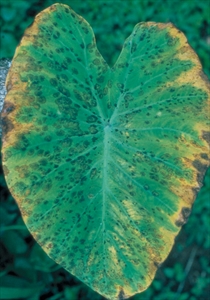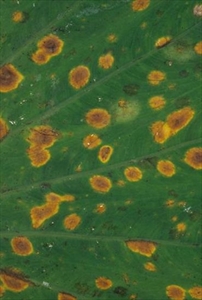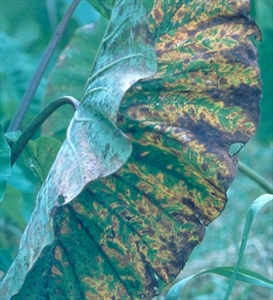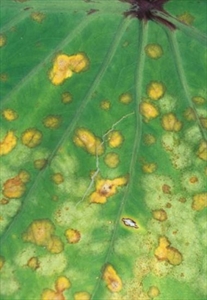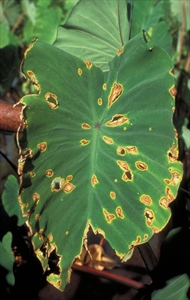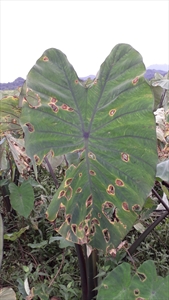Brown or ghost leaf spot, orange leaf spot, white leaf spot and shot-hole
Pacific Pests, Pathogens, Weeds & Pesticides - Online edition
Pacific Pests, Pathogens, Weeds & Pesticides
Taro minor leaf spots (094)
Cladosporium colocasiae (brown or ghost leaf spot), Neojohnstonia colocasiae (orange leaf spot), Pseudocercospora colocasiae (white leaf spot), Phoma sp.(shot-hole). Phoma sp. is often given as Phyllosticta colocasiicola.
These leaf spots are predominantly present in Asia, Southeast Asia, Oceania.
Cladosporium colocasiae: Australia, American Samoa, Cook Islands, Federated States of Micronesia, Fiji, French Polynesia, Kiribati, Marshall Islands, New Caledonia, New Zealand, Niue, Palau, Papua New Guinea, Samoa, Solomon Islands, Tahiti, Tonga, Vanuatu, and Wallis & Futuna. Probably, this fungus has the widest distribution of all those that colonise taro and is likely to be present wherever the crop is grown.
Neojohnstonia colocasiae: American Samoa, Federated States of Micronesia, Fiji (Rotuma), Palau, Papua New Guinea, Samoa, Solomon Islands, Tuvalu, and Wallis & Futuna.
Pseudocercospora colocasiae: American Samoa, Fiji, French Polynesia, New Caledonia, Papua New Guinea, Samoa, Solomon Islands, and Vanuatu.
Phoma: Phoma has been mistaken for taro leaf blight in Fiji and Vanuatu where large spots develop. Distribution uncertain.
Taro
Brown or ghost leaf spot: Spots yellow at first (Photos 1&2); later, reddish brown spots and blotches with light brown centres, round or irregular up to 15 mm diam. There are fewer spots on the under surface of leaves because not all spots penetrate the leaf, hence the name 'ghost spot'. Spots may merge causing leaves to dry out at the margins (Photo 2).
Orange leaf spot: Yellow-brown, round or irregular spots, up to 15 mm diam., on both sides of the leaf (Photos 3-5). Sometimes the spots have a yellow margin. Spots become darker on the lower surface as spores develop.
White leaf spot: On the upper surface spots are whitish-green, up to 15 mm diam. (Photo 6-8); on the lower surface spots have dark centres as spores develop, leaving a whitish margin.
Shot-hole: Brown spots, enlarging to 20 mm, round. oval or irregular, distinctive as the centres fall out (Photos 9&10). Often the holes have a bright yellow halo or margin. Some spots merge forming larger shot-holes.
These leaf spots are especially common where rainfall is high. The fungi are spread by wind, rain-splash, and wind-blown rain. The diseases are found in both coastal and mountain areas; shot-hole is more common in highland areas and/or at cooler times of the year.
Four fungi cause these leaf spots. They are mostly found on the older leaves, and are unlikely to affect corm yields, though further studies are needed to confirm this. Leaf spot symptoms associated with the four fungi are similar, except for shot-hole.
Look for spots with diffuse margins, lacking a clear line between diseased and healthy areas of the leaf. Look for spots that are present on the top surface of the leaf but not penetrating to the underside. Look for spots with dark velvety centres where the spores form, more noticeable on the underside of the leaves. It is difficult to tell the difference between brown, orange and white leaf spots in the field; a microscope is needed to confirm the diseases by looking at their spores. Look for spots where the centres have fallen out, giving a shot-hole effect.
Although these diseases are common, they are not a threat to taro production; they mostly affect older leaves causing them to die earlier than they would if they were healthy, but not to the extent that they would affect corm yields.
RESISTANT VARIETIES
It is likely that there are differences between varieties in susceptibility to the four diseases, but this is only obvious for shot-hole, Phoma sp. For instance, in Fiji, the variety Toakula is more susceptible, especially in the cooler times of the year compared to other varieties. Shot-hole is sometimes confused with taro leaf blight (see Fact Sheet no. 14)
CHEMICAL CONTROL
As these diseases cause little economic loss, fungicides are not recommended.
AUTHORS Helen Tsatsia & Grahame Jackson
Information from Carmichael A, et al. (2008) TaroPest: an illustrated guide to pests and diseases of taro in the South Pacific. ACIAR Monograph No. 132, 76 pp. (https://lrd.spc.int/about-lrd/lrd-project-partners/taropest); Photos 2,5&6 (Gerlach WWP (1988) Plant diseases of Western Samoa. Samoan German Crop Protection Project, Deutsche Gesellschaft für Technische Zusammenarbeit (GTZ) Gmbh, Germany. Photos 3&4 (taken by Eric McKenzie), and used in this fact sheet, appeared previously in McKenzie E (2013) Neojohnstonia colocasiae. PaDIL - (http://www.padil.gov.au). Photo 6-8 (taken by Eric McKenzie), and used in this fact sheet, appeared previously in McKenzie E (2013) Pseudocercospora colocasiae. PaDIL - (http://www.padil.gov.au). Photo 10 Mani Mua, SPC, Sigatoka Research Station, Fiji.
Produced with support from the Australian Centre for International Agricultural Research under project PC/2010/090: Strengthening integrated crop management research in the Pacific Islands in support of sustainable intensification of high-value crop production, implemented by the University of Queensland and the Secretariat of the Pacific Community.
